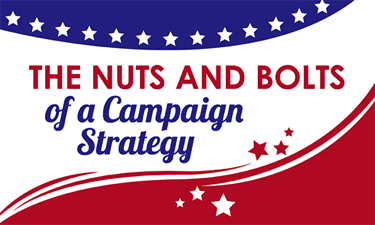The Nuts and Bolts of a Campaign Strategy
Oct 05

In an interview earlier this year, President Obama’s former speechwriter said that the television show, House of Cards resembles American politics about as accurately as The Walking Dead portrays modern suburban Atlanta. There’s a perception, maybe because of the depiction of campaigns and the political world in popular culture, that elected officials, candidates, and campaigns are calculatingly and cynically pulling levers to impact the course of an election. The reality, at least in my experience, is far different. More often than not, it’s the slow, deliberate, day-to-day execution of a very basic plan – finding supporters and ensuring they participate.
After graduating from Simpson College in 2003, I almost immediately joined a presidential campaign serving as a field organizer in five central and southern Iowa counties. In that role, my responsibilities included completing a nightly four to five hour call time directly engaging likely caucus goers, identifying supporters, and persuading undecideds. It also involved going door-to-door multiple times per week and interacting with activists face-to-face. Over the course of eight months, I must have spoken with thousands of people with the goal of establishing a network of supporters, volunteers, and precinct captains throughout that five-county area committed to dedicating their time free of charge to my candidate.
For the various Republican and Democratic presidential campaigns active today, this process is again underway, although it receives far less attention than the events taking place across the state or the debates being carried on television nationally. And while organization does not replace the performance of the candidate in engaging activists and likely caucus goers, it is one of the key factors in determining who is successful on caucus night, particularly on the Democratic side.
Within the Democratic precinct caucus, it is easy to fixate on the relatively arcane elements of the process; preference groups, viability threshold, delegate equivalents, among others. However, caucus night provides the very last opportunity for each campaign to persuade activists to support their candidate. Those that do not reach a minimum number of attendees in the initial alignment have the opportunity to choose another candidate to support. Consider 2008 as an example. By and large, the Biden, Richardson, and Dodd campaigns did not reach that threshold in most precincts across the state, meaning the Obama, Clinton, and Edwards campaigns had the opportunity to win an additional and meaningful percentage of caucus attendees. Considering only 0.2 percent separated the Edwards and Clinton campaigns that year, the skill in which each campaign went about that process proved to be critical to the end result.
Since it is not possible for a campaign to have paid staff in all of the nearly 1,800 Iowa precincts, they need to rely on well-trained volunteer precinct captains to manage this enterprise on caucus night. Those individuals need to have a clear understanding of the process and the ability to make a compelling case as to why their preferred candidate is best suited to win the general election and succeed once in office.
A recent CBS poll found Senator Bernie Sanders leading Hillary Clinton 43 percent to 33 percent here in Iowa. That is, of course, an interesting finding considering Clinton entered the campaign as the clear frontrunner. However, the poll does not take into account two critical factors.
One, eight years ago the Clinton campaign secured more than 70,000 caucus goers and built an incredibly strong statewide network of precinct captains in the process. That gives their campaign an incredible head start in establishing a supporter base large enough to win next year and a volunteer network capable of managing the process on caucus night. Two, the other announced candidates are, at this point nowhere, near the minimum threshold necessary to win delegates on caucus night. As a result, the more experienced team of Clinton precinct captains might be better positioned to win over supporters of Governor Martin O’Malley, former Senator Jim Webb, and former Governor Lincoln Chafee.
Both of those factors don’t guarantee a win for Hillary Clinton on caucus night, but it does give her a distinct advantage that so far has not been widely reported. It’s far from the intricate plot points of a political movie or television show, but it is the sort of nuts and bolts campaign strategy that may make the difference between a first place finish and a significant step toward the nomination or a second place finish and a possibly protracted fight.
